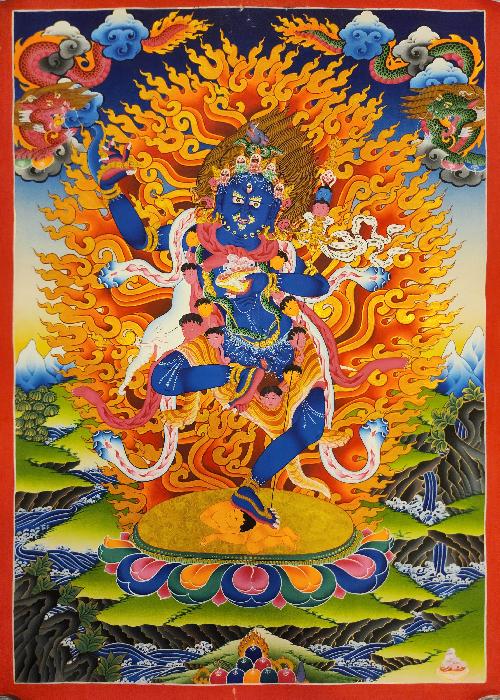If You find this to be Empty please Click the buttons above

Nairatmya Yogini is a female Buddha in Tibetan Buddhism, the consort of Hevajra in the Hevajra-tantra. She is also known as Dagmema, which means "ego-less woman." Nairatmya is a powerful symbol of non-duality and emptiness, and she is often depicted with three eyes, bared fangs, and a crown of skulls.
Iconography
Nairatmya is typically depicted as a black-skinned figure with one face and two hands. She is often seated in a lotus position, with her right hand holding aloft a curved knife and her left hand holding a skullcup to her heart. She may also be depicted with a katvanga (a ritual staff) in the bend of her elbow. Nairatmya's three eyes represent her ability to see the past, present, and future, and her bared fangs represent her fierce determination to overcome ignorance and delusion. The crown of skulls represents the death of the ego, and the skullcup represents the nectar of wisdom.
History
The cult of Nairatmya originated in India, where she was first worshipped as a yogini. She was later introduced to Tibet, where she became one of the most important deities in the Buddhist pantheon. Nairatmya is often seen as a patron deity of tantric practitioners, and she is frequently depicted in mandalas and thangkas.
Temples and Monasteries
There are no temples dedicated specifically to Nairatmya in Nepal, but she is often worshipped in temples dedicated to other deities, such as Hevajra and Vajrayogini. There are also a number of monasteries in Nepal where Nairatmya is worshipped, such as the Sakya Monastery in Kathmandu and the Gyume Tantric Monastery in Dolpo.
Benefits of Practicing Nairatmya
There are many benefits to practicing Nairatmya, including:
Increased non-dual awareness
Reduced attachment to the ego
Increased compassion for others
Improved mental clarity
Increased peace and happiness
How to Practice Nairatmya
There are many different ways to practice Nairatmya. Some common practices include:
Chanting the mantra "Om Nairatmya Hum"
Visualizing Nairatmya
Offering prayers and supplications to Nairatmya
Serving others in the spirit of Nairatmya
Mantras of Nairatmya
The most famous mantra of Nairatmya is "Om Nairatmya Hum." This mantra is said to have many benefits, including:
Removing obstacles
Accumulating merit
Achieving enlightenment
Conclusion
Nairatmya Yogini is a powerful and compassionate deity who can help us to develop our own non-dual awareness and compassion. By practicing Nairatmya, we can bring more peace and happiness into our own lives and into the world.
Loading..
Please wait for the page to fully load for optimal functionality.